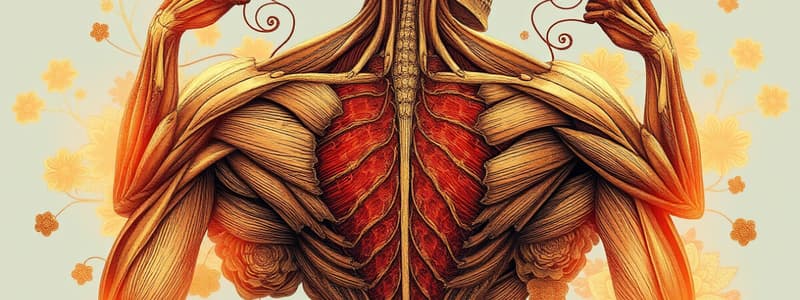Podcast
Questions and Answers
What are the three types of muscle tissue?
What are the three types of muscle tissue?
Smooth muscle tissue, striated (skeletal) muscle tissue, and cardiac muscle tissue.
How do voluntary and involuntary muscles differ? Give an example of each type of muscle.
How do voluntary and involuntary muscles differ? Give an example of each type of muscle.
Voluntary muscles move when you tell them to, and involuntary muscles work without you being conscious of it. An example of voluntary muscles are smiling, and an example of involuntary muscles are your heart beating.
Suppose one of the tendons in a person's index finger were cut. How would it affect movement in the finger?
Suppose one of the tendons in a person's index finger were cut. How would it affect movement in the finger?
The finger would not be able to move because the tendons are the things that make your bones attach to muscles.
Where might you find muscle pairs?
Where might you find muscle pairs?
Describe how the muscles in your upper arm work together to bend and straighten your arm.
Describe how the muscles in your upper arm work together to bend and straighten your arm.
When exercising to build muscular strength, why is it important to exercise both muscles in a muscle pair equally?
When exercising to build muscular strength, why is it important to exercise both muscles in a muscle pair equally?
How do muscles work?
How do muscles work?
Flashcards are hidden until you start studying
Study Notes
Muscle Tissue Types
- Smooth muscle tissue: involuntary control, found in organs.
- Striated (skeletal) muscle tissue: voluntary control, responsible for body movement.
- Cardiac muscle tissue: involuntary control, makes up the heart.
Voluntary vs Involuntary Muscles
- Voluntary muscles: consciously controlled, examples include smiling or moving arms.
- Involuntary muscles: function without conscious control, example includes the heart beating.
Tendon Function in Movement
- Tendons connect muscles to bones; if one is cut, movement of the associated bone is impaired.
- Inability to move the finger occurs when a tendon is severed.
Muscle Pairs Location
- Muscle pairs are commonly found in various body regions, particularly the upper arm.
Coordination in Upper Arm Muscles
- To bend or straighten the arm, one muscle contracts while its paired muscle relaxes to restore original length, enabling movement.
Importance of Balanced Muscle Training
- Equal exercise of muscle pairs is crucial to prevent injuries like tendon pulls; neglecting one muscle can lead to imbalances.
Muscle Interaction
- Muscles generally function in pairs, requiring coordinated efforts for movement.
Studying That Suits You
Use AI to generate personalized quizzes and flashcards to suit your learning preferences.





